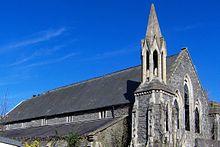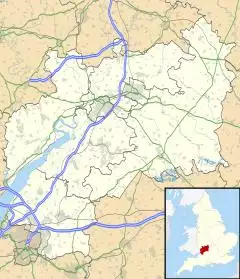| Whitefield's Tabernacle, Kingswood | |
|---|---|
 West side showing roof and window damage to the Masters Church which is just west of the Whitefield Tabernacle building | |
| Religion | |
| Affiliation | United Reformed |
| District | Kingswood |
| Location | |
| Location | South Gloucestershire, England |
| Geographic coordinates | 51°27′47″N 2°30′25″W / 51.4631°N 2.5069°W |
| Architecture | |
| Completed | 1741 |
Whitefield's sometimes Whitfield's Tabernacle is a former Calvinistic Methodist and Congregational (now United Reformed)[1] church in Kingswood, a town on the eastern edge of Bristol where George Whitefield preached in the open air to coal miners. The name refers to two buildings in which the church met.
The congregation originally met in the New Society Room which was built in 1741 for George Whitefield and John Cennick after a separation occurred between them and John Wesley.[1] The former Society Room building was expanded to a large size, and is a grade I listed building.[2] It is now roofless and derelict after an arson attack.[3]
In 1851 a very large Gothic building, designed by Henry Masters, was constructed just west of the original tabernacle. In the late 20th century this building was closed and the United Reformed Church congregation moved back into the original 18th-century building for a few years, before leaving both buildings to join together for worship with another congregation associated with the 18th-century revival, the Moravian Church, in the Moravian building on the other side of the High Street.
In 2003 the Tabernacle featured in the BBC's Restoration series.[4]
As of 2007, there were plans for the redevelopment of the three listed buildings on the Tabernacle site, namely the two churches and the 18th century Chapel House. Besides various proposed memorial facilities, the plan includes flats in the Chapel House and the 19th century building.[3] At February 2011 the site was still derelict although the large disused churchyard had been cleared of vegetation.[5]
As at February 2015 the site is still derelict and the graveyard is once again overgrown.
See also
References
- ^ a b Timothy Jenkins (1999). Religion in Everyday English Life: an Ethnographic Approach. New York: Berghahn. pp. 103–105.
- ^ "Whitfield's Tabernacle". historicengland.org.uk. Retrieved 13 March 2007.
- ^ a b "Save the Tabernacle". A Social History of Bristol in photographs & stories. Archived from the original on 7 August 2008. Retrieved 25 April 2009.
- ^ "Whitfield Tabernacle". BBC - History - Restoration - Series 1. Retrieved 21 March 2007.
- ^ "Whitefield's Tabernacle". The Derelict Miscellany. Retrieved 5 October 2015.
External links
- Ordnance Survey grid reference ST648738
- A Social History of Bristol in Photographs & Stories page on the Kingswood Tabernacle
- Heritage at Risk Register: Whitfields+tabernacle
- Whitfield Tabernacle Conservation Area
- Restoration - Whitfield Tabernacle at South Gloucestershire Council site
- The PG Group future project placeholder page with aerial artist's impression
